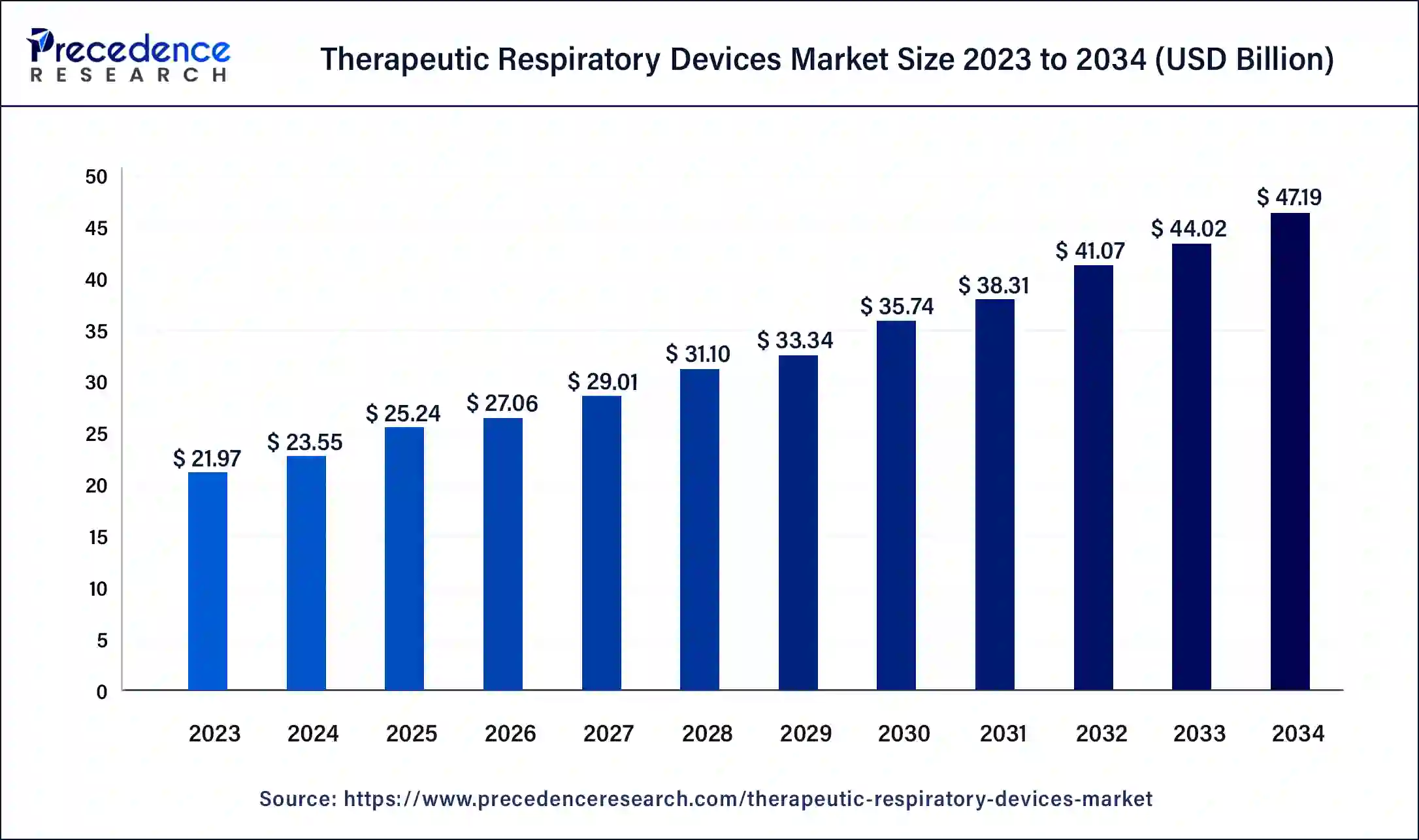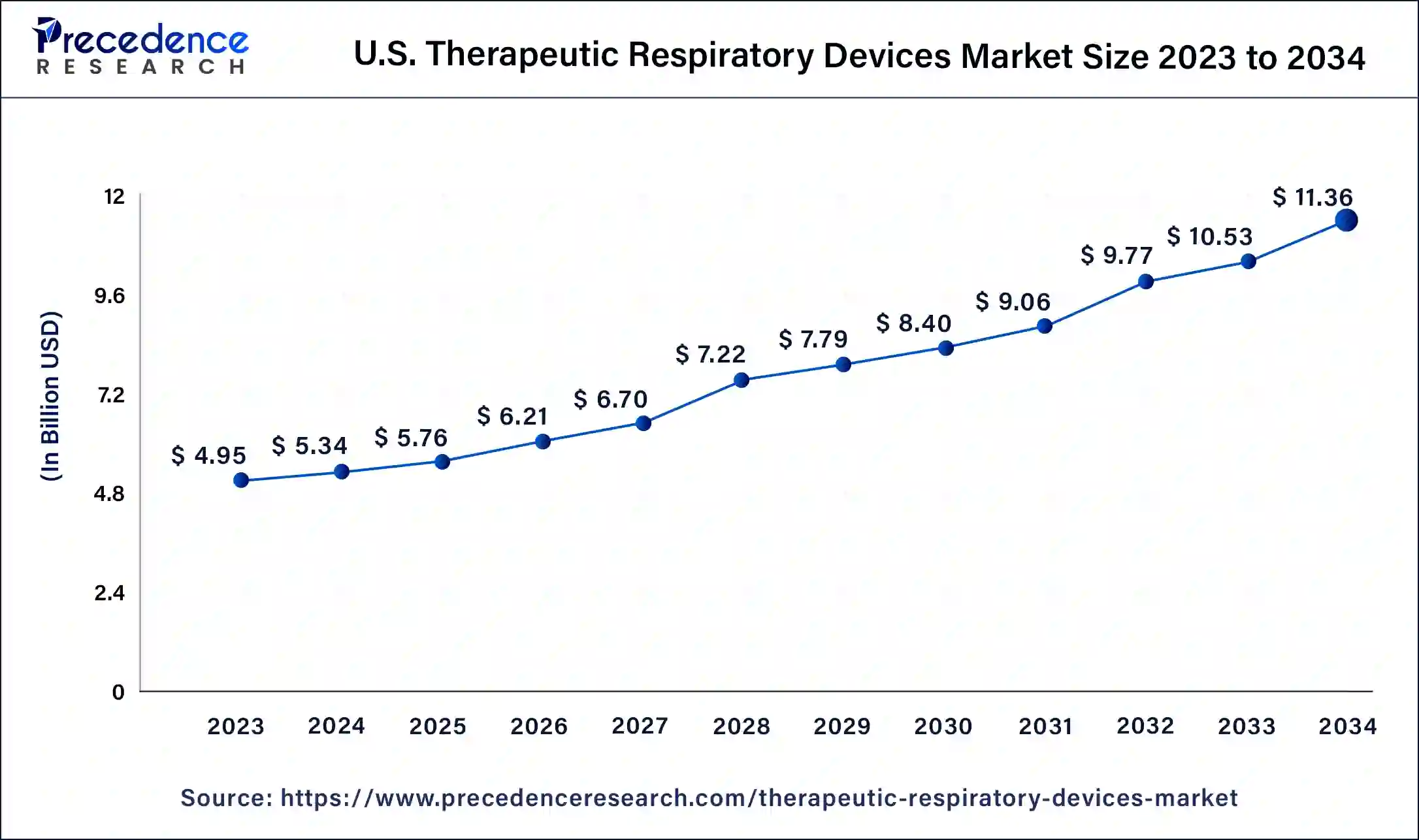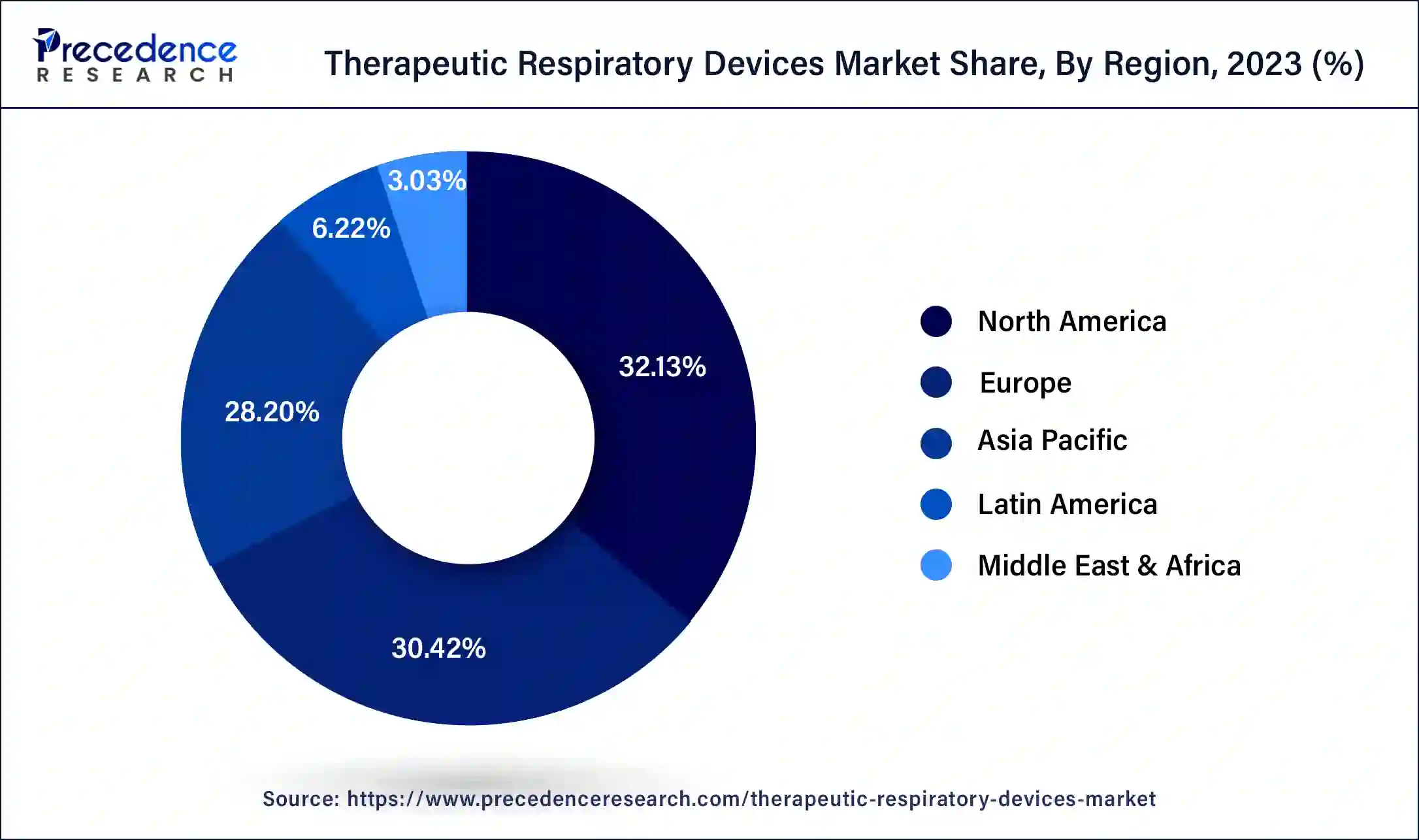January 2025
Therapeutic Respiratory Devices Market (By Types: Ventilators, Nebulizers, Oxygen Therapy Devices, Positive Airway Pressure Devices; By End-User: Hospitals, Home Healthcare, Emergency Centers) - Global Industry Analysis, Size, Share, Growth, Trends, Regional Outlook, and Forecast 2024-2034
The global therapeutic respiratory devices market size was USD 21.97 billion in 2023, accounted for USD 23.55 billion in 2024, and is expected to reach around USD 47.19 billion by 2034, expanding at a CAGR of 7.2% from 2024 to 2034.

The U.S. therapeutic respiratory devices market size was estimated at USD 4.95 billion in 2023 and is predicted to be worth around USD 11.36 billion by 2034, at a CAGR of 7.8% from 2024 to 2034.

On the basis of geography, North America dominates the market, primarily driven by the growing demand for healthcare infrastructure in various industries. During the forecast period, the region is expected to witness significant growth in the therapeutic respiratory devices market. This is due to various factors, such as the growing adoption of advanced technology and the high prevalence of respiratory diseases. The United States and Canada are the major countries driving the demand for therapeutic respiratory devices in the North American region. These countries have a robust healthcare system and high healthcare expenditures. In addition, these countries are investing heavily in healthcare infrastructure and advanced technology, which is expected to drive the demand for therapeutic respiratory devices in the region.
Europe is expected to be a significant market for therapeutic respiratory devices, with Germany, the United Kingdom, and France being the major contributors to the market's growth. This is due to well-developed healthcare systems expected to significantly impact the market. These countries have well-established industries that are major consumers of respiratory healthcare, and they are investing heavily in developing healthcare infrastructure and advanced technology.

The region in Asia-Pacific is anticipated to have the greatest CAGR. The market is driven by the increasing healthcare expenditure and rising respiratory health awareness contributing to this region's market growth. China, Japan, and India are the major countries driving the demand for therapeutic respiratory devices in Asia-Pacific. These countries have well-established industries, particularly in the healthcare infrastructure and advanced technology, which are major consumers of respiratory health. Moreover, these countries invest heavily in developing healthcare infrastructure and advanced technology, which is expected to drive the region's demand for therapeutic respiratory devices market.
Market Overview
Therapeutic respiratory devices deliver respiratory therapy and improve the breathing process for patients with acute respiratory conditions, chronic respiratory diseases, and respiratory failure. The key objective is to provide effective and innovative medical devices that assist individuals with respiratory conditions or disorders. These devices improve respiratory health, which helps individuals with respiratory diseases or conditions breathe more easily, enhance lung function, and manage respiratory symptoms effectively.
The growing geriatric population, home healthcare settings, and the increasing advancement in product technology drive the market. The increasing number of elderly individuals globally is a significant driver for the market. The elderly population is more prone to respiratory diseases and conditions such as COPD, pneumonia, and sleep apnea. As the senior population expands, the demand for therapeutic respiratory devices rises, driving market growth. They often experience a higher burden of chronic respiratory diseases, requiring ongoing respiratory support.
Furthermore, home healthcare settings, including the rising demand for therapeutic respiratory devices, drive market growth significantly. It allows individuals with respiratory conditions to receive necessary care and treatment in the comfort of their own homes. This trend has gained momentum as it offers convenience, cost-effectiveness, and the ability to enhance patients' quality of life. Thus, the therapeutic respiratory devices market is expected to grow significantly in the coming years as industries increasingly adopt devices tailored to meet the needs of patients who require respiratory support at home, including those with chronic respiratory diseases or recovering from acute respiratory illnesses.
However, the high cost of therapeutic respiratory devices, limited infrastructure, and stringent regulatory requirements impede market growth. The market for therapeutic respiratory devices is subject to severe regulatory requirements and approval processes. Manufacturers must meet stringent standards and obtain necessary certifications before bringing their products to the market. These regulatory hurdles can slow the introduction of new devices and increase costs for manufacturers. Moreover, Strategies such as streamlining regulatory processes, improving reimbursement policies, increasing awareness, and investing in training and support infrastructure can help overcome these challenges and foster the growth of the therapeutic respiratory devices market.
The lockdown measures implemented by various governments in anticipation of the COVID-19 pandemic have caused disruptions in supply chains and manufacturing, leading to a slowdown in economic activity, and a sudden increase in demand for respiratory devices during the pandemic resulted in shortages and supply chain disruptions. However, the respiratory complications associated with COVID-19, including severe acute respiratory distress syndrome (ARDS), led to a surge in demand for therapeutic respiratory devices. Devices such as ventilators, oxygen concentrators, and respiratory support systems became critical in managing the respiratory distress caused by the virus. The unprecedented demand strained the supply chain and manufacturing capabilities of these devices.
| Report Coverage | Details |
| Market Size in 2023 | USD 21.97 Billion |
| Market Size in 2024 | USD 23.55 Billion |
| Market Size by 2034 | USD 47.19 Billion |
| Growth Rate from 2024 to 2034 | CAGR of 7.2% |
| Largest Market | North America |
| Base Year | 2023 |
| Forecast Period | 2024 to 2034 |
| Segments Covered | By Types and By End-User |
| Regions Covered | North America, Europe, Asia-Pacific, Latin America, and Middle East & Africa |
Increasing prevalence of respiratory diseases to brighten the market prospect
Respiratory conditions such as chronic obstructive pulmonary disease (COPD), asthma, pneumonia, and sleep apnea are becoming more prevalent globally. Thus rise in prevalence creates a greater demand for therapeutic respiratory devices that aid in managing and treating these conditions. Therefore, the growing number of individuals affected by respiratory diseases directly contributes to expanding the therapeutic respiratory device market. These devices are crucial in delivering medication, improving respiratory function, and enhancing patient respiratory care.
The growing prevalence of respiratory diseases drives the demand for existing therapeutic respiratory devices and stimulates research and development efforts for innovative and advanced devices. Manufacturers continually strive to develop new technologies and products to meet the evolving needs of patients and healthcare providers, fueling market growth. Furthermore, governments and industries worldwide are investing heavily in developing oxygen concentrators, nebulizers and ventilators, which is anticipated to drive the growth of the therapeutic respiratory devices market. As the infrastructure for oxygen concentrators, nebulizers and ventilators and distribution networks expands, the demand for therapeutic respiratory devices will likely increase to meet the needs of this growing market.
Growing geriatric population
With advancements in medical technology and improved access to healthcare, people are living longer, resulting in a larger population of elderly individuals. This aging population is prone to respiratory ailments such as chronic obstructive pulmonary disease (COPD), asthma, and sleep apnea, requiring specialized therapeutic interventions. Geriatric individuals often experience a decline in lung function and respiratory muscle strength, making them more susceptible to respiratory illnesses. Therapeutic respiratory devices such as inhalers, nebulizers, and positive airway pressure devices are essential in managing and treating these conditions. Inhalers deliver medication directly to the lungs, quickly relieving respiratory symptoms. Nebulizers convert liquid medication into a fine mist that can be inhaled, ensuring efficient drug delivery. Positive airway pressure devices like continuous positive airway pressure (CPAP) machines treat sleep apnea by maintaining a continuous flow of air to keep the airways open during sleep.
The growing geriatric population is fueling the demand for these therapeutic respiratory devices as healthcare providers strive to meet the respiratory care needs of this demographic. Manufacturers are investing in research and development to develop innovative devices that are user-friendly, portable, and provide enhanced treatment efficacy. In addition, rising healthcare expenditures, government initiatives to improve respiratory care, and increasing patient awareness contribute to the expanding market for therapeutic respiratory devices. Thus, the increasing geriatric population is a significant driving force behind the demand for therapeutic respiratory devices.
The high cost of therapeutic respiratory devices is causing hindrances to the market
The affordability and accessibility of these devices are crucial factors that impact their adoption and usage among patients and healthcare providers. The high price tags associated with therapeutic respiratory devices create financial barriers for patients, particularly those without comprehensive insurance coverage or limited financial resources. This constraint is particularly prominent in developing countries or regions with lower-income populations where affordability is a major concern. In addition, healthcare facilities often face budget constraints, and the high cost of these devices can strain their financial resources. Hospitals and clinics may find investing in expensive respiratory devices challenging, leading to a lower adoption rate or a delay in upgrading to more advanced and costly technologies.
Moreover, reimbursement policies and coverage for these devices vary across different healthcare systems and insurance plans. Inadequate reimbursement or limited coverage can discourage healthcare providers from prescribing or recommending these devices, further impacting their demand. The competitive nature of the market also contributes to pricing pressure. Manufacturers may lower prices to gain a competitive edge, but excessively low pricing can hinder profitability and investments in research and development. This may limit introduction of new and innovative devices that could enhance patient outcomes.
On the basis of types, the therapeutic respiratory devices market is divided into ventilators, nebulizers, oxygen therapy devices, and positive airway pressure devices, with the ventilators segment accounting for most of the market. Their critical role in respiratory care mainly drives the demand for ventilators therapeutic respiratory devices. However, ventilators are widely used in various healthcare settings, including hospitals, intensive care units, and emergency departments, to support mechanical ventilation for individuals with respiratory failure or those requiring breathing assistance.
On the basis of end-user, the therapeutic respiratory devices market is divided into hospitals, home healthcare, and emergency centers, with hospitals accounting for most of the market. They have the infrastructure, healthcare professionals, and resources to handle complex respiratory cases and provide comprehensive care. Therapeutic respiratory devices improve respiratory health and patient well-being, evolving the needs of individuals with respiratory conditions.
Recent Developments
Segments Covered in the Report:
By Types
By End-User
By Geography
For inquiries regarding discounts, bulk purchases, or customization requests, please contact us at sales@precedenceresearch.com
No cookie-cutter, only authentic analysis – take the 1st step to become a Precedence Research client
January 2025
January 2025
March 2025
February 2025